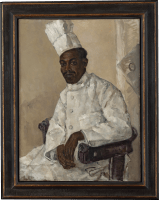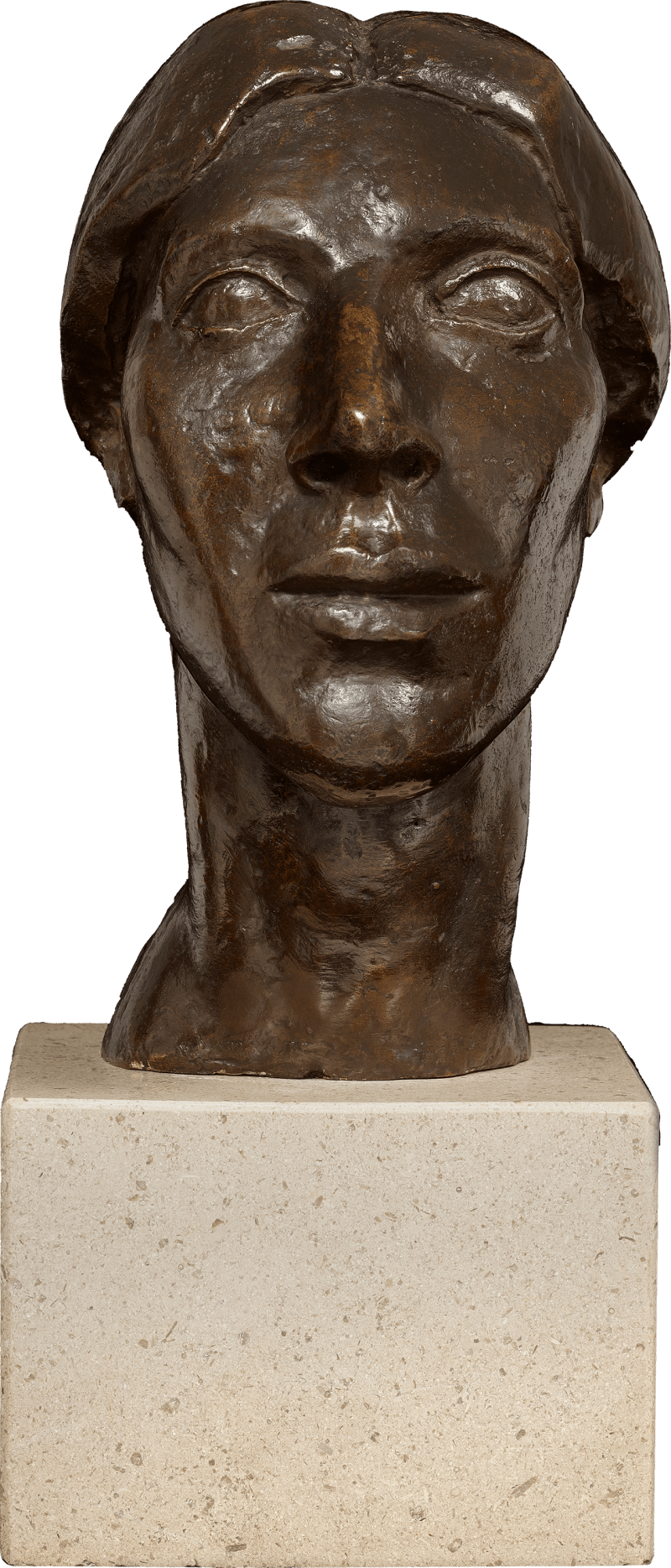Painted by Stanley Grimm in 1959, this portrait is of particular significance as one of the earliest known depictions of a Caribbean chef in British art. Though the sitter’s identity remains unknown, a partially torn label on the reverse, inscribed “Antigu”, has recently been matched to the painting’s original exhibition title: Chef from Antigua, confirming the sitter’s profession and Antiguan heritage.
The sitting took place in the artist’s Chelsea studio, evidenced by the palette hanging in the background and the distinctive armchair present in other portraits by the artist. The portrait is marked by a reaching informality: the chef sits in a relaxed pose, hands resting easily in his lap, meeting the viewer’s gaze with quiet assurance. This seeming familiarity between the sitter and the artist, combined with the gestural quality of Grimm’s brushwork, transcends the strictures of formal portraiture. Loose, expressive brushstrokes define the folds of the uniform and the studio background, imbuing the composition with a sense of...
Painted by Stanley Grimm in 1959, this portrait is of particular significance as one of the earliest known depictions of a Caribbean chef in British art. Though the sitter’s identity remains unknown, a partially torn label on the reverse, inscribed “Antigu”, has recently been matched to the painting’s original exhibition title: Chef from Antigua, confirming the sitter’s profession and Antiguan heritage.
The sitting took place in the artist’s Chelsea studio, evidenced by the palette hanging in the background and the distinctive armchair present in other portraits by the artist. The portrait is marked by a reaching informality: the chef sits in a relaxed pose, hands resting easily in his lap, meeting the viewer’s gaze with quiet assurance. This seeming familiarity between the sitter and the artist, combined with the gestural quality of Grimm’s brushwork, transcends the strictures of formal portraiture. Loose, expressive brushstrokes define the folds of the uniform and the studio background, imbuing the composition with a sense of movement and immediacy.
By the late 1950s, when this work was painted, Britain was in the midst of the Windrush era, with Caribbean migrants contributing significantly to the labour force, particularly in sectors such as transport, healthcare, and hospitality. London hotels, clubs, and restaurants actively recruited Caribbean employees as part of the postwar reconstruction effort. Yet this period was also defined by widespread racial hostility. This portrait was painted the year after the Notting Hill race riots of 1958, a watershed moment marked by violent attacks on Caribbean residents and inflamed by far-right demonstration. In submitting this portrait for the Royal Society of Portrait Painters annual exhibition just one year later, Grimm invited an overwhelmingly conservative audience to acknowledge a dignified image of a Black subject, in a genre traditionally reserved for white sitters.
Grimm’s portrait also enters a broader artistic tradition of representing chefs and kitchen workers: most famously Claude Monet’s Portrait of Père Paul, Chaïm Soutine’s expressive series of kitchen professionals, and Sir William Orpen’s Le Chef de l’Hôtel Chatham, Paris. Collectively these works gave artistic visibility to a profession typically concealed from public view, carried out behind the scenes in kitchens, away from the diners they served.
Stanley Grimm biography
Grimm was born in London and descended from the Brothers Grimm, of Fairy Tale renown. Orphaned by age three, he grew up in Riga before studying at the Knirr Atelier in Munich during the Blaue Reiter movement, absorbing the visual language of artists like Wassily Kandinsky and Paul Klee. He exhibited in Berlin and Venice as a young man and married a fellow artist, Masha Oulpe. His life was interrupted by war: interned in Germany during WWI, he returned to England via prisoner of war exchange, only to travel to Russia in 1918, where he was conscripted by the Bolsheviks to paint propaganda posters. He escaped on a smuggler’s fishing boat via Finland to London.
In London, Grimm’s bold use of colour and instinctive compositions attracted admiration from the likes of Henri Matisse, who called him a gifted painter. Though he refused Royal Academy membership, his work was nevertheless exhibited there to great acclaim. He exhibited widely and was elected a member the Royal Institute of Oil Painters in 1935 and the Royal Institute of Portrait Painters in 1936, where he exhibited in 1937 a portrait of the President, Sir John Lavery, which was described as “dominating the main gallery”. Today, his work is held in private and public collections, including the Government Art Collection (London) and Sheffield Museums.











